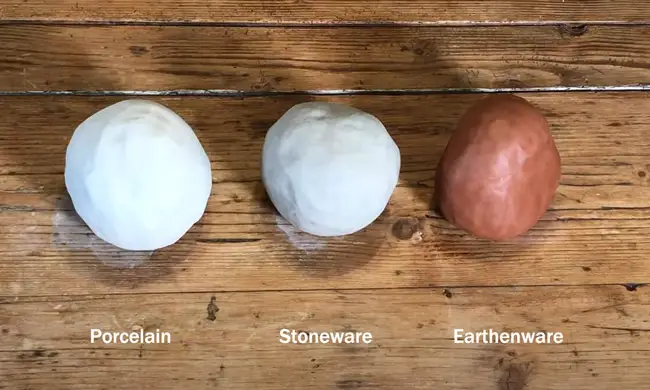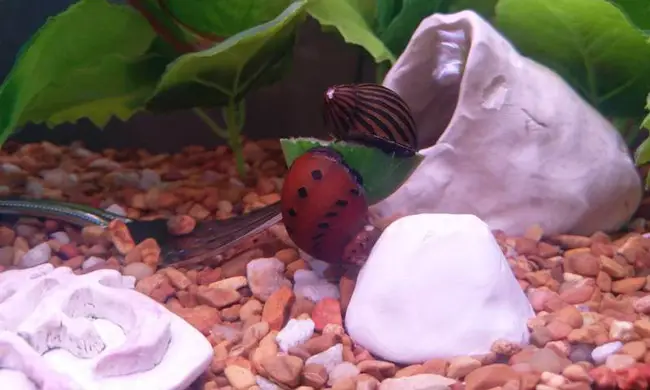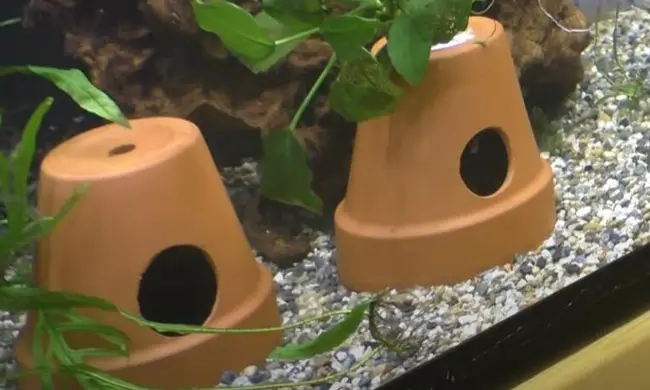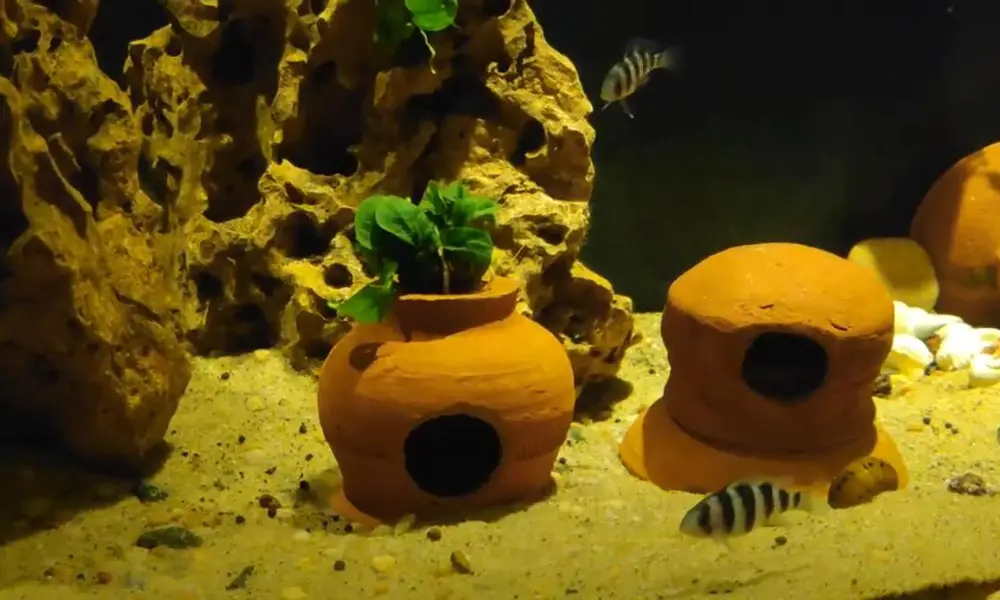In my last article, John shared his failure story of using clay to make Harry Potter aquarium decor. I don’t want to call it a failure because it’s a learning experience that will help us become better aquarists.
His story inspired me to dig a little deeper and learn more about the use of clay in aquariums. I think this can be helpful for many fish keepers who are DIYing their own aquarium decorations.
What is Clay and Clay Body?
Before discussing the safety of clay for aquarium use, we need a basic knowledge of clay and clay body.
Clay is the oldest known ceramic material. I’m sure you might know this already. It’s a natural product derived from the chemical weathering of rocks [1]. Essentially, it’s made up of silica, water, and minerals, like alumina, magnesia, iron, potassium, and calcium.
The use of clay in pottery can be traced back to prehistoric times. No other soil material has such wide uses as the clay due to its working properties – it’s plastic when wet, so you can make any shape you like, while it becomes coherent, hard, and can be carved and scraped when dried or fired.
Clay dries pretty quickly depending on the thickness and humidity of the piece as evaporation happens. At this point, you can add water to rewet the clay and make it workable again. So whatever shape you make with the clay, it’s not permanent until it’s fired.
The term “clay body” is used to define a mixture of different types of clays in the ceramic industry.
Virtually no potter uses a single type of clay when working. A potter usually uses two or three types of clay to get their working properties, such as color, texture, and durability.
Three general categories of commercial clay bodies are used in ceramics: stoneware, earthenware, and porcelain.
What Kind of Clay is Aquarium Safe?

Generally speaking, whether the material is aquarium safe or not depends on what it’s made of and what kind of chemicals it might release into the water.
As for clay, we already know that it needs to be kiln fired to be properly “cured.” Otherwise, it’s just dried clay and will fall apart in water.
Of course, it’s more than that, let me try and explain why.
As always, everything in this post is just my personal opinion based on my research, and your mileage may vary.
If you think I’m wrong, please let me know in the comment and explain why. I’m always looking to learn, and I truly believe that there is nothing that would make me happier than improving my aquarium husbandry skills.
Now that we got that out of the way let’s talk about fired clay.
All commercially fired clay products are not created equal. Either the firing process or the ingredients used can result in different final products, which might be more or less aquarium safe.
There are several distinctions [2] between these three clay bodies before and after firing [3].
| Earthenware | Stoneware | Porcelain | |
|---|---|---|---|
| Firing Temperatures | 600 to 1100 °C | 1200 to 1300 °C | 1250 to1400 °C |
| Color | Grey, orange, or red | Buff to gray to dark brown | White |
| Texture | Medium | Coarse (containing grog) | Smooth |
| Earthenware | Stoneware | Porcelain | |
|---|---|---|---|
| Porosity | > 15 % | < 3 % | non-porous |
| Color | Grey, orange, or red | white, buff, grey and black | Pure white translucent body |
| Price | Cheap | Expressive | Most Expensive |
You might have noticed that the differences that will affect how safe the clay body is for aquarium use are firing temperature, color and texture.
Temperature & Porosity
Different clay bodies “mature” or melt at different temperatures. In general terms, the higher the firing temperature a clay body can mature, the more vitreous it is and the lower its porosity. Of course, they will melt if fired to the maximum higher temperatures.
Earthenware clays have lower “mature” temperatures resulting in softer, porous fired products and a trend to absorb water.
Porosity [4] is important to consider when using clay in aquariums because it can affect how susceptible the clay can absorb water. The more water it absorbs, the more chance it will leach chemicals into the water.
Color
Another difference is color. The difference in color is greatly affected by the minerals that are used in the clay body.
Different minerals will give the clay body different colors when fired, ranging from white to buff to brown.
Porcelain is pure white or translucent because of its high kaolin (also known as China Clay) content and lack of other minerals.
Stoneware is somewhere in between gray to dark brown due to the small amounts of iron oxide content and other minerals ‘impurities”.
Earthenware is typically gray, red, or orange in color both before and after firing.
Texture
The texture is something that generally refers to the workability and body roughness of the clay body, which is affected by a particulate additive called grog.
Grog is a coarse particulate, also known as firesand and chamotte, and is commonly made of sand or fired clay. It directly reduces the total shrinkage rate of the clay (usually about 8-12%), depending on the amount.
Porcelain clays don’t have any grog, resulting in the highest shrinkage rate, making them extremely difficult to work with, so your DIYed aquarium backgrounds and decorations made of porcelain will crack easily during the firing process. That’s why most beginning potters avoid using porcelain.
So, What’s My Solution?
When considering these properties, we can see that stoneware is the best type of clay body to use in aquariums. It’s non-porous, easy to work with, and has a very low chance of leaching out minerals.
But that’s not the whole story.
Just ask yourself this question- how to fire your clayey aquarium decorations? With earthenware, its low firing temperature is 1112 °F (600 °C). Most ovens can’t reach that temperature.
I know this part makes many DIYers nervous.
As a fish keeper, safety is always my first priority. But that doesn’t mean I don’t want stylish and personalized decorations. So what’s the solution?
After some failed attempts, I found that the best way is to use the clay and silicone to cast a mold, fill the mold with resin, then paint and seal the resin, so it’s non-toxic and safe for aquarium use.
And on top of that, let’s introduce another material- polymer clay. It’s a type of modeling clay that is cured by baking in an oven due to its low temperature of 275 °F (130 °C).
Is Polymer Clay Aquarium Safe?

Polymer clay is essentially a polyvinyl chloride compound with a non-toxic plasticizer and fillers. Popular brands include FIMO and Sculpey.
Sculpey has claimed that its product is absolutely safe [5] as long as it has been properly cured. Fimo has the same ingredients.
I found these two products have a mixed reaction in the aquarium community.
Some people have used unpainted and unglazed products in their aquariums for years with no issues. While others reported that the clay could leach out chemicals, lose color, and become brittle.
Personally, I think it’s better to be safe than sorry. That’s why I would not recommend using polymer clay in your aquariums. Additionally, only aquarium-safe paint should be used if you choose to glaze polymer clay in your aquarium.
Are Clay Pots Aquarium Safe?

Clay pots provide perfect breeding caves and shelters for fish like bristlenose and cichlids. The most commonly used clay pots are called terracotta pots. Terracotta (or terra cotta) is actually unglazed earthenware used for sculpture and pottery.
Since terracotta post undergoes high temperatures several times (when it’s made and then when it’s fired), it’s safe for aquariums. However, only a natural terracotta pot should be used in your aquarium.
As we mentioned before, earthenware is porous and tends to absorb water.
So, if the terracotta pots have been used before, they could be contaminated with harmful chemicals. Also, DO NOT use dyed, painted, and glazed terracotta pots, as the paint can chip off and leach into the water.
To be on the safe side, it’s better to soak the new terracotta pot in boiling water and seal it with aquarium-safe silicone before using it in your tank.
What do you think?
As always, the above is just my own opinion, and I would love to hear your thoughts and story in the comments below.
There are other materials to make your aquarium decoration. Epoxy resin is one that comes to mind.
If you found this article helpful, please share it with your friends and family who are looking for safe and stylish ways to decorate their aquarium.
Article Sources:
- Environmental Characteristics of Clays and Clay Mineral Deposits [Usgs.gov]
- Clay Types, Geology, Properties and Color Chart (GcCeramics) [Glendale.edu]
- Ceramics [Government of Western Australia]
- Clay Body Porosity [DigitalFire]
- Using Polymer Clay in Fish Tanks or Snow Globes [Sculpey]
- Ceramics 101 [Skutt]

Just a couple of clarifications and some questions:
The amounts of temper (grog) in earthenware and stoneware varies depending on the firing method, with rapid heating and cooling demanding more temper to combat thermal shock. Temper is not always grog and there are options which result in a relatively smooth finish in both earthenware and stoneware. Earthenware allows for burnishing, which will create very smooth surface finishes without adding glaze chemicals (the shine diminishes at higher heats). Stoneware does still retain some porosity (though less than earthenware). The ‘high heat’ of terracotta firing doesn’t change the chemical components that you are concerned about elsewhere. Low-firing of clay is possible in a bonfire setting, and clay is common in my area of the world. I would love to delve more into this topic on a practical side, but I am restricted by my current circumstances.
I’m left with these questions: Would soaking, as with wood components, reduce the risk of seepage? Would seepage from clay be likely to harm fish given the dilution involved and regular water changes? Do you know any details about clay filter materials? Would it be possible to increase bacterial filtration by adding porous earthenware features near the filter outflow? Can the higher iron content in red earthenware be accessed by iron-loving plants in a tank? I would love to hear if you know any more details about this!